Papers by Maria Beatrice Valli
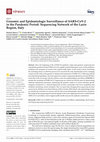
Viruses
Since the beginning of the COVID-19 pandemic, large-scale genomic sequencing has immediately poin... more Since the beginning of the COVID-19 pandemic, large-scale genomic sequencing has immediately pointed out that SARS-CoV-2 has rapidly mutated during the course of the pandemic, resulting in the emergence of variants with a public health impact. In this context, strictly monitoring the circulating strains via NGS has proven to be crucial for the early identification of new emerging variants and the study of the genomic evolution and transmission of SARS-CoV-2. Following national and international guidelines, the Lazio region has created a sequencing laboratory network (WGSnet-Lazio) that works in synergy with the reference center for epidemiological surveillance (SERESMI) to monitor the circulation of SARS-CoV-2. Sequencing was carried out with the aims of characterizing outbreak transmission dynamics, performing the genomic analysis of viruses infecting specific categories of patients (i.e., immune-depressed, travelers, and people with severe symptoms) and randomly monitoring variant...
International Journal of Infectious Diseases
Clinical pediatrics, Mar 4, 2024
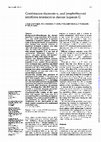
Gut, 1996
Background-Monotherapy for chronic hepatitis C using interferon (IFN) results in a very small pro... more Background-Monotherapy for chronic hepatitis C using interferon (IFN) results in a very small proportion of patients exhibiting a sustained response. Clinical trials assessing the benefit of combination drug therapy may provide evidence of improved treatment response over that seen with single drug treatment. Aim-To assess the response in patients with chronic hepatitis C to one year of combination treatment: thymosin al (Tal), 1 mg twice weekly, and lymphoblastoid (L)-IFN, 3 MU thrice weekly. Patients and Methods-Fifteen patients with serum HCV RNA positive chronic hepatitis C were studied. Eleven patients were treatment naive and four had failed previous standard IFN therapy. Thirteen patients were HCV RNA serotype lb. All patients were given combination Tao and L-IFN therapy for one year with a six month follow up period. Results-Six months after initiation of treatment seven patients (47%) were sera HCV RNA negative and at completion of the one year treatment 11 (73%), including two who had failed previous standard IFN treatment, had negative serum HCV RNA. Six months after treatment, six patients (40°/0), including five with HCV type lb, showed a sustained response characterised by a negative serum HCV RNA. Conclusions-The results of this open label trial suggest that there may be a potential benefit to combining an immune modulator (Ta1) with an antiviral (IFN) in the treatment of chronic hepatitis C. Verification of the observations in this study require completion of a randomised controlled study.

International Journal of Environmental Research and Public Health
A descriptive analysis of common respiratory pathogens (CRPs) detected in nasopharyngeal swabs (N... more A descriptive analysis of common respiratory pathogens (CRPs) detected in nasopharyngeal swabs (NPSs) from hospitalized patients with influenza-like illness during the fall seasons of the past three years, 2019–2021, in the Lazio region, Italy, was conducted to assess whether or not CRP circulation changed because of COVID-19 during the fall season. The results observed in a total of 633 NPSs subjected to molecular diagnosis for CRPs by multiplex PCR assay during the autumn seasons (exactly from week 41 to week 50) were compared with each other. In 2019, in 144 NPSs, the more represented CRPs were rhinovirus/enterovirus (7.6%) and influenza A/B (4.2%). In 2020, 55 (21.6%) out of 255 NPSs resulted positive for SARS-CoV-2 and, except for one case of Legionella pneumophila, the CRPs detected were exclusively rhinovirus/enterovirus (4.7%). In 2021, among 234 NPSs, 25.6% resulted positive for SARS-CoV-2, 14.5% for respiratory syncytial virus (RSV), and 12.8% for rhinovirus/enterovirus. C...

Scientific Reports, 2021
Prophylactic low molecular weight heparin (pLMWH) is currently recommended in COVID-19 to reduce ... more Prophylactic low molecular weight heparin (pLMWH) is currently recommended in COVID-19 to reduce the risk of coagulopathy. The aim of this study was to evaluate whether the antinflammatory effects of pLMWH could translate in lower rate of clinical progression in patients with COVID-19 pneumonia. Patients admitted to a COVID-hospital in Rome with SARS-CoV-2 infection and mild/moderate pneumonia were retrospectively evaluated. The primary endpoint was the time from hospital admission to orotracheal intubation/death (OTI/death). A total of 449 patients were included: 39% female, median age 63 (IQR, 50–77) years. The estimated probability of OTI/death for patients receiving pLMWH was: 9.5% (95% CI 3.2–26.4) by day 20 in those not receiving pLMWH vs. 10.4% (6.7–15.9) in those exposed to pLMWH; p-value = 0.144. This risk associated with the use of pLMWH appeared to vary by PaO2/FiO2 ratio: aHR 1.40 (95% CI 0.51–3.79) for patients with an admission PaO2/FiO2 ≤ 300 mmHg and 0.27 (0.03–2.18)...

Diagnostics
We report two cases of SARS-CoV-2 recombinant variant XE detected in nasopharyngeal swabs (NPS) o... more We report two cases of SARS-CoV-2 recombinant variant XE detected in nasopharyngeal swabs (NPS) of hospitalized patients with no evident epidemiological link in Lazio, Central Italy. Whole-Genome Sequencing (WGS) performed on an Ion Torrent GSS5 platform according to Italian flash surveys showed genomes corresponding to the PANGOLIN unclassified lineage and the Nextclade XE clade. Further analyses were then carried out to investigate more deeply the genetic characteristics of these XE-like sequences. When phylogenetic trees, by using IQ-TREE, were built splitting the genome into two regions according to the putative XE recombination site, the upstream and downstream regions were seen to be clustered near BA.1 and BA.2 sequences, respectively. However, our XE-like sequences clustered separately, with a significant bootstrap, from the classified European and Italian XE strains, although the recombination site between BA.1 and BA.2 was identified at the nucleotide site 11556 by RDP4 so...
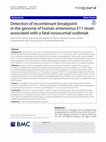
Virology Journal
Background The aim of this study was to characterize the genome of a recombinant Enterovirus asso... more Background The aim of this study was to characterize the genome of a recombinant Enterovirus associated with severe and fatal nosocomial infection; it was typed as Echovirus 11 (E-11) according to the VP1 gene. Enterovirus infection is generally asymptomatic and self-limited, but occasionally it may progress to a more severe clinical manifestation, as in the case described here. Recombination plays a crucial role in the evolution of Enteroviruses (EVs) and has been recognized as the main driving force behind the emergence of epidemic strains associated with severe infection. Therefore, it is of utmost importance to monitor the circulation of recombinant strains for surveillance purposes. Methods Enterovirus-RNA was detected in the serum and liver biopsy of patients involved in the nosocomial cluster by commercial One-Step qRT-PCR method and the Enterovirus strains were isolated in vitro. The EVs typing was determined by analyzing the partial-length of the 5′UTR and VP1 sequences wit...
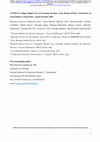
COVID-19 pandemic is becoming one of the most dramatic health, social and economic global challen... more COVID-19 pandemic is becoming one of the most dramatic health, social and economic global challenges in recent history. Testing is one of the main components of the public health response to contain the virus spreading. There is an urgent need to expand testing capacity and antigen rapid tests (Ag RDT) represent good candidates for point-of-care and mass surveillance testing to rapidly identify people with SARS-CoV-2 infection, counterbalancing lower sensitivity as compared to the gold standard molecular tests with timeliness of results and possibility of recurred testing. Here, we report preliminary data of the testing algorithm implemented at the points-of-entry (airports and port) in Lazio Region (Central Italy) on travelers arriving between 17th of August to 15th of October, 2020, using the STANDARD F COVID-19 Antigen Fluorescence ImmunoAssay. Our findings show that the probability of molecular confirmation of Ag RDT positive results is directly dependent from the semi-quantitat...
Clinical Microbiology and Infectious Diseases, 2016

Journal of Medical Virology, 2007
It was reported previously that HCV can be transmitted from persistently infected human bone-marr... more It was reported previously that HCV can be transmitted from persistently infected human bone-marrow-derived B-lymphoblastoid cells (TO.FE(HCV)) to human hepatoma cells by cell-to-cell contact. The present study confirms and characterize further such type of HCV infection in vitro. TO.FE(HCV) cells were co-cultured with 2.2.15 hepatoma cells, that are not susceptible to cell-free infection by sera containing HCV of 1b genotype. By this co-cultivation system it was demonstrated that HCV transmission to recipient cells requires de novo virus RNA replication. Several factors may favor HCV-transmission, evidence is provided that TO.FE(HCV) cells were able to select HCV-quasispecies. 5'-UTR and core sequence analysis revealed differences in the HCV-quasispecies composition in serum inoculum and in infected TO.FE B-cells at 4 months post-inoculation. It is considered that the latter may be more successful in replicating HCV in vitro and used to express surface molecules which may be involved in cell-to-cell contact. In TO.FE(HCV) cells replicate distinct, or few close related, HCV-variants correlated with those of serum inoculum. Comparative analysis of tetra-spans and integrins expression undertaken by cytofluorimetry displayed higher level of expression for TO.FE cells in comparison to other human bone-marrow-derived B-cell lines. Overall, the observed persistent in vitro HCV replication is mediated by a continuous cell-to-cell reinfection that may be favored by selection of viral variants and expression of molecules involved in cell adhesion. These observations may provide an explanation for the establishment of HCV infection, the occurrence of chronic infection and HCV-related lymphoproliferative diseases.
Journal of Clinical Microbiology, 2010
Molecular testing of 270 consecutive nasopharyngeal swab samples taken in May and June 2009 and 2... more Molecular testing of 270 consecutive nasopharyngeal swab samples taken in May and June 2009 and 274 samples from patients hospitalized between July and December 2009 showed similar findings of respiratory viruses, with influenza A pandemic virus H1N1/09 being the most represented, followed by human parainfluenza virus type 3 and rhinoviruses. Statistical analyses suggested virus cocirculation in the absence of viral interference.

Amyloid, 2000
A form of beta-amyloid peptide A beta ending at amino acid 42 (A beta42) is the major component o... more A form of beta-amyloid peptide A beta ending at amino acid 42 (A beta42) is the major component of senile amyloid plaques in Alzheimer's Disease (AD). The A beta-peptide earliest modifications are extremely important since they constitute the key events in the progression towards further changes finally leading to fibril formation and to A beta deposits which constitute the core pathological change in AD. Chemical and conformational early modifications of the beta-amyloid peptide are critical steps in AD pathogenesis and have been widely investigated. We now show that a Fenton-type OH-generating system is capable of generating L-Dopa (3,4-dihydroxyphenylalanine) in the tyrosine residue of A beta-peptide via aromatic ring hydroxylation, as the result of hydroxyl radical attack on proteins. Since L-Dopa is not a constituent of mammalian proteins and peptides, the formation of L-Dopa in A beta in vitro constitutes a possible important modification caused by hydroxyl radical attack. These results lay the groundwork for further studies on modification and damage associated with the degenerative disorder in AD where oxidative stress and inflammation are known to occur.
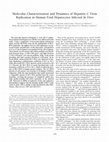
Hepatology, 1997
The molecular features of hepatitis C virus (HCV) replica-Most of the questions concerning non-A,... more The molecular features of hepatitis C virus (HCV) replica-Most of the questions concerning non-A, non-B (NANB) tion in human fetal hepatocytes (HFHs) were addressed in this human hepatitis have been answered in the last few years study. Using a competitive reverse-transcription polymerase using the recombinant DNA technology 1,2 ; several NANB chain reaction (RT-PCR) assay for the quantitation of HCVagents have been identified, among them hepatitis C virus RNA molecules, the highest level of viral replication was de-(HCV), 3 which is responsible for the vast majority of parentected 30 days' postinfection. At this time point, viral particles terally transmitted NANB hepatitis, and novel flavi-like viof 41 to 45 nm in diameter accumulated in the cell cytoplasm. ruses associated with acute and chronic human hepatitis. 4 Their density in cell extracts and culture medium was distrib-Molecular cloning and sequencing 5 of the HCV genome have uted between heavy (1.180-1.360 g/cm 3) and light fractions clarified most aspects of viral genome organization. 3 This (1.105-1.050 g/cm 3) of a sucrose gradient, while, in the serum knowledge, combined with the availability of in vitro systems inoculum, they had a positive fraction at 1.180 g/cm 3. In infor the expression of HCV genes, has rapidly improved the fected HFHs, minus-strand HCV RNA was observed in fracdiagnosis and control of HCV infection. 6-8 At the same time, tions displaying a sedimentation coefficient of 28 S to 18 S, the absence of tissue culture model systems for propagating while plus-strand HCV RNA showed a peak restricted to the HCV efficiently 9 has hampered not only the understanding 21 S fraction; the HCV RNA of serum inoculum had a sediof its life cycle, but also the analysis of the molecular determimentation coefficient of 38 to 40 S, which revealed the presnants of its persistence. ence of HCV RNA of unique positive polarity. The 21 S RNA So far, the early steps of HCV infection, as well as the late fraction of cell extracts was resistant to 20 minutes of RNase phases of genome replication and secretion of mature virions, I digestion, while the same incubation time totally inactivated have only incompletely been described. Experimental studies a comparable amount of HCV RNA purified from the serum on transmission and expression of NANB agents have initially inoculum, revealing the presence of completely and/or parbeen performed in vivo using the chimpanzee 10-12 model systially double-stranded HCV-RNA molecules in the infected tem. More recently, a cell culture system for primary hepatocells. Detection in HFHs of replicative forms and replicative cytes from infected baboons 13 has yielded chronically inintermediates suggests that the dynamic profile of HCV replifected liver cultures. 14 The release of virus-like particles cation in these cells is similar to that described in other flavi-(VLPs) in the culture medium has been achieved using hepaviruses. (HEPATOLOGY 1997;26:1328-1337.) tocytes isolated from the liver of chimpanzees acutely infected with NANB strains, 15-18 and VLPs of approximately 50 nm in diameter (similar to the virions observed in concentrated sera from HCV-infected patients) 19 have been detected in the cytoplasmic vesicles of these liver specimens. 20 Finally, Abbreviations: NANB, non-A, non-B; HCV, hepatitis C virus; VLPs, virus-like particles; RT-PCR, reverse-transcription polymerase chain reaction; HFHs, human fetal chimpanzee hepatocytes have been shown to be susceptible hepatocytes; TEM, transmission electron microscopy; PBS, phosphate-buffered saline; to HCV infection in vitro.

Copyright © 2010 Giuseppe Gristina et al. This is an open access article distributed under the Cr... more Copyright © 2010 Giuseppe Gristina et al. This is an open access article distributed under the Creative Commons Attribution License, which permits unrestricted use, distribution, and reproduction in any medium, provided the original work is properly cited. The first patient with influenza A/H1N1-related pneumonia was admitted to an Italian ICU at the end of August 2009. Until then, despite the international alarm, the level of awareness was low and very few Italian hospitals were equipped with ECMOs. Moreover the PCR test for A H1N1 virus was sporadically available and the emergency departments of even the largest institutions could rely only on the rapid test for the urgent screening of patients with pneumonia and respiratory failure. On September 5th, a young and “apparently ” previously healthy man, was admitted to our ICU because of a severe ARDS caused by influenza A H1N1 virus. As there was no ECMO available, he was treated with prolonged cycles of prone positioning ventilatio...
International Journal of Infectious Diseases, 2020
We report two cases of COronaVIrus Disease-19 in patients with Down Syndrome and describe the ide... more We report two cases of COronaVIrus Disease-19 in patients with Down Syndrome and describe the identification, diagnosis, clinical course, and management of the infection. Down Syndrome, which is caused by trisomy 21, is characterized by immune dysregulation, anatomical differences in the upper respiratory tract, and higher rate of comorbidities. All these risk factors can contribute to more severe clinical presentations of COVID-19. It is essential to raise awareness of the clinical relevance of SARS-COV-2 infection in DS patients, as well in other most vulnerable patients in order to improve their management and treatment and to candidate these individuals for vaccination, once available.

Journal of Antimicrobial Chemotherapy
Background Remdesivir is a prodrug of the nucleoside analogue GS-441524 and is under evaluation f... more Background Remdesivir is a prodrug of the nucleoside analogue GS-441524 and is under evaluation for treatment of SARS-CoV-2-infected patients. Objectives To evaluate the pharmacokinetics of remdesivir and GS-441524 in plasma, bronchoalveolar aspirate (BAS) and CSF in two critically ill COVID-19 patients. Methods Remdesivir was administered at 200 mg loading dose on the first day followed by 12 days of 100 mg in two critically ill patients. Blood samples were collected immediately after (C0) and at 1 (C1) and 24 h (C24) after intravenous administration on day 3 until day 9. BAS samples were collected on Days 4, 7 and 9 from both patients while one CSF on Day 7 was obtained in one patient. Remdesivir and GS-441524 concentrations were measured in these samples using a validated UHPLC-MS/MS method. Results We observed higher concentrations of remdesivir at C0 (6- to 7-fold higher than EC50 from in vitro studies) and a notable decay at C1. GS-441524 plasma concentrations reached a peak a...
We report phylogenetic and mutational analysis by NGS of six SARS-CoV-2 strains from patients fly... more We report phylogenetic and mutational analysis by NGS of six SARS-CoV-2 strains from patients flying from Bangladesh to Italy (July 2020). Data suggest that no further circulation of such imported strains occurred in Italy, stating the efficacy of early screening at the point of entry and supporting the importance of molecular epidemiology in monitoring the efficacy of control measures.








Uploads
Papers by Maria Beatrice Valli